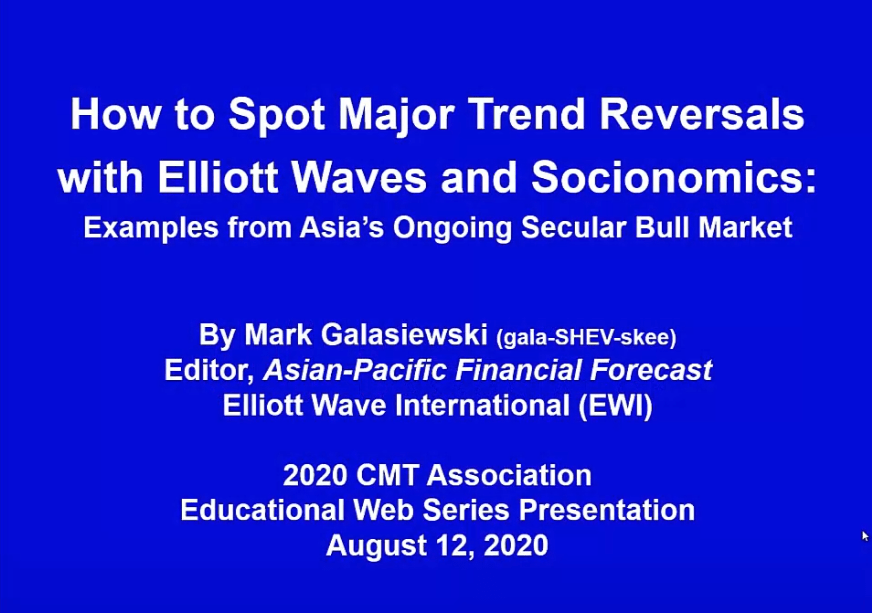Just when everyone pooh-poohs our beloved “Sell in May” saw, it somehow starts to work. Or maybe it was just that the S&P 500 hit resistance on waning momentum? Hmm. I, for one, do not blame a tweet. And I also don’t expect this series of coincidences to dictate my summer outlook. By the way, as I write this, the Dow is right where it was when it (and the Spoo) scored their golden crosses in late March. The truth is that the markets have changed since some of our indicators were created or discovered, and we have to change with them. That’s why it is so important to keep learning. And keep respecting your “stops” on indicators that no longer produce results. What better place to learn that at the TAN Association annual symposium? This year’s is in the books, but even if you were unable to attend, you’ll be able to get a few insights from the presenters. We’ve got summaries of several of them in this newsletter edition. If you were there and took notes, we’d love to get a
To view this content you must be an active member of the TAN Association.
Not a member? Join the TAN Association and unlock access to hundreds of hours of written and video technical analysis content, including the Journal of Technical Analysis and the Video Archives. Learn more about Membership here.
What's Inside...
Copyright Basics, Part 2
by Joyce L. Miller & Dr. C. Daniel MillerIn our first article, in last month’s edition of Technically Speaking, we touched on the need to determine whether certain uses of copyrighted content require copyright permission. We briefly...
Stephen Cox Memorial
by Michael Kahn, CMTLongtime TAN Association member, Stephen Cox, passed away on April 6, 2019, at age 69. Steve and his wife, Kate, met in Chicago in 1981, then moved to Brooklyn, where he landed a job with the...
Member Interview with John Kosar, CMT of Asbury Research
by John Kosar, CMTPlease tell us what you do professionally. I am Chief Market Strategist for Asbury Research, an investment research firm I launched in 2005, and a Managing Principal of Asbury Investment Management...
2019 Symposium Speaker Summaries: Behavioral Finance Panel Discussion: “Navigating the Behavioral Gap”
by Brett Villaume, CMT, CAIAPanelists: Clare Flynn-Levy, Jason Voss, CFA, C. Thomas Howard, Ph.D., and Brett Whysel Moderated by Rick Lehman — Behavioral Finance and its application was the topic of discussion at the...
2019 Symposium Speaker Summaries: The Power of Momentum
by Brett Villaume, CMT, CAIASpeaker: Julie Dahlquist, Ph.D., CMT — Often cited as a tool that bridges the gap between fundamental and technical analysis, Momentum has been mentioned many times at the Symposium, but...
2019 Symposium Speaker Summaries: Yes, There IS Alpha in the Marketplace
by Dave Lundgren, CMT, CFASpeaker: Chris Cain The premise of Chris Cain’s presentation was to build a portfolio of ETFs combining several separate technical models. Of course, this is not a new concept, nor was it my...
2019 Symposium Speaker Summaries: Cognitive and Emotional Biases - Mitigate or Accommodate?
by Brett Villaume, CMT, CAIASpeaker: Dr. Greg Filbeck, CFA, FRM, CAIA, CIPM, PRM — Behavioral biases are issues we deal with when we work with clients, but we also display them ourselves as money managers and...
2019 Symposium Speaker Summaries: FICC strategy and Intermarket overview
by James Brodie, CMTSpeakers: George Davis, CMT and Paul Ciana, CMT — George Davis started with a brief evolution of the changes witnessed in technical analysis during his career. These included the evolution...
2019 Symposium Speaker Summaries: Point & Figure Chart Construction – Tracking Supply and Demand
by Brett Villaume, CMT, CAIASpeaker: Tom Dorsey — Tom’s career began in 1974 as a stock broker for Merrill Lynch, just at the end of the worst bear market since the Great Depression. Early in his career he read...
2019 Symposium Speaker Summaries: Future Trends in Investment Management
by James Brodie, CMTSpeaker: Stavros Iatridis — Stavros strongly believes we are on the cusp of dramatic changes in our industry. We are seeing slower growth and a continued decline in the workforce as global...
2019 Symposium Speaker Summaries: Integrating Technical Analysis into a Fundamental Framework
by Salma Abdulla, CFA, CMTSpeaker: Blaze Tankersley, CMT, CFA — There is a myth that technicals and fundamentals should be separate, but Blaze’s take on this logic is that “technical things happen for...
2019 Symposium Speaker Summaries: Technical Market Analysis: Industry Perspectives
by Brett Villaume, CMT, CAIASpeaker: Michael Santoli — As the opening presentation of the TAN Association’s 46th Annual Symposium, Mike Santoli presented his view of Technical Analysis over the course of his career,...
2019 Symposium Speaker Summaries: The Role of Technical Analysis in Portfolio Construction and Position Sizing
by Salma Abdulla, CFA, CMTSpeaker: Louis Llanes, CMT, CFA Topic: How do quantitative technical techniques improve decision making for portfolio managers in a multi-disciplinary environment? Goal: to improve portfolio...
“Ethics” Video Series Available from CFA Institute
by Stanley Dash, CMTTAN Association members know that the Association has adopted the CFA Institute Code of Ethics and Standards of Professional Conduct. The TAN Association website reads, in part: Code of Ethics...
2019 Annual Meeting Notice
by Robert Palladino, CMTThe Annual Meeting of the TAN Association, Inc. membership is fast approaching and will take place on Tuesday, June 11, 2019 at 10:00 am New York Time. Online proxy voting for the annual meeting...
Membership News for May 2019
by Marie PenzaThe TAN Association would like to congratulate the following members on their new positions: Miguel Rito, Trainee Departamento Comercial at Juniscap Business Solutions Michael Stroud, CFP,...
In our first article, in last month’s edition of Technically Speaking, we touched on the need to determine whether certain uses of copyrighted content require copyright permission. We briefly identified two categories in which permission may not be required: fair use and public domain. In this article, we will discuss the first of these: fair use.
Fair Use
Last month, we introduced the fair use doctrine as a means to foster the free flow of ideas in society. It is an attempt to balance the protection of intellectual property rights with the right of free speech given in the 1st amendment to the U.S. Constitution. Because this balancing act is complex and involves subjective decisions made on a case by case basis in a court of law, a cautious decision to count on a claim of fair use requires careful consideration. An intelligent determination by the user or their publisher of whether
To view this content you must be an active member of the TAN Association.
Not a member? Join the TAN Association and unlock access to hundreds of hours of written and video technical analysis content, including the Journal of Technical Analysis and the Video Archives. Learn more about Membership here.
Contributor(s)

Joyce L. Miller
Joyce L. Miller is The Copyright Detective®. She is a freelance copyright specialist and copyright compliance consultant to content providers, writers, authors, independent publishers, and publishing support teams. She is an award-winning author and an educator...

Dr. C. Daniel Miller
Dr. C. Daniel Miller is a freelance consultant on the business of independent publishing, copyright clearance and compliance, management of copyright permissions acquisition projects, project management of independent publishing, marketing and distribution of publications, and...
Longtime TAN Association member, Stephen Cox, passed away on April 6, 2019, at age 69.
Steve and his wife, Kate, met in Chicago in 1981, then moved to Brooklyn, where he landed a job with the Commodities Research Bureau. They married in 1983. While at the CRB, Steve became intrigued by technical analysis and eventually founded his own market advisory service, Heaviside Economics.
In 1986, they bought a house in Stillwater Township, NJ. He worked for Dow Jones Newswires in New York, and was the first technical analyst employed by the company. He retired in 2013 after 20 years of service.
Steve was instrumental in the creation in 1994 of the Charles H. Dow Award recognizing outstanding research in technical analysis. As a representative of the namesake Dow Jones and Company, he was part of the committee that defined the award and served as the committee chair for several years.
He became an association
To view this content you must be an active member of the TAN Association.
Not a member? Join the TAN Association and unlock access to hundreds of hours of written and video technical analysis content, including the Journal of Technical Analysis and the Video Archives. Learn more about Membership here.
Contributor(s)

Michael Kahn, CMT
Michael Kahn, who holds a Chartered Market Technician (CMT) designation, is a seasoned financial services strategist, analyst, columnist, educator and speaker. Michael has been working with charts and technical analysis since 1986. He is the author of three books on...
Please tell us what you do professionally.
I am Chief Market Strategist for Asbury Research, an investment research firm I launched in 2005, and a Managing Principal of Asbury Investment Management (AIM), an asset management firm I co-founded in 2018.
How did you get there?
After working 17 years on the floor of the Chicago Mercantile Exchange in the 1980s and 1990s learning the business, I took a job as the fixed income technician at BridgeNews. From there, I went out on my own.
Who was an early mentor in your career?
John Murphy
What book/author was most influential in helping you understand TA?
Edwards and Magee and Murphy’s books.
What do you like to do when you are not looking at markets?
I enjoy spending time with my friends at dinners, movies and shows. Lately, I’ve been re-learning to play the piano, and, of course, being with my relatively new granddaughter.
What brought you
To view this content you must be an active member of the TAN Association.
Not a member? Join the TAN Association and unlock access to hundreds of hours of written and video technical analysis content, including the Journal of Technical Analysis and the Video Archives. Learn more about Membership here.
Contributor(s)

John Kosar, CMT
John Kosar, CMT, is the Chief Market Strategist of Asbury Research LLC, a firm he launched in 2005. Asbury Research provides a blend of technical and quantitative investment research to both institutional and private investors. In addition, John is also the Chief Investment...
Panelists: Clare Flynn-Levy, Jason Voss, CFA, C. Thomas Howard, Ph.D., and Brett Whysel
Moderated by Rick Lehman
—
Behavioral Finance and its application was the topic of discussion at the opening session on Thursday. The panel consisted of a diverse group of asset managers, investment advisors and consultants with broad qualifications within the study of Behavioral Finance, including authoring academic journals, textbooks, and even CFA curricula on the topic.
Rick introduced the theme of the panel as “behavioral alpha,” which is a relatively new term. One can approach the topic from both a micro and macro perspective: micro being the focus on individual’s behavioral biases, which create a negative alpha, versus the macro perspective, or the combined biases of all market participants.
The panelists provided brief introductions to themselves and their work. Clare works with money managers who are interested in recapturing the negative alpha of behavioral biases.
Tom helps clients avoid behavioral mistakes, but
To view this content you must be an active member of the TAN Association.
Not a member? Join the TAN Association and unlock access to hundreds of hours of written and video technical analysis content, including the Journal of Technical Analysis and the Video Archives. Learn more about Membership here.
Contributor(s)

Brett Villaume, CMT, CAIA
Brett Villaume, CMT, CAIA, is Vice President of the TAN Association and has served on the Board of Directors since 2014. Additionally, Brett is Senior Vice President and Director of Investor Relations of Opus Bank, a regional commercial bank headquartered in Irvine,...
Speaker: Julie Dahlquist, Ph.D., CMT
—
Often cited as a tool that bridges the gap between fundamental and technical analysis, Momentum has been mentioned many times at the Symposium, but exactly is it?
Merriam-Webster defines it as “a strength or force gained by motion or by a series of events.” But there are hundreds of synonyms for momentum that could mean something similar. They all basically mean there is a force behind a price movement. Based on the laws of supply and demand, price can increase if demand increases or supply increases. So, what would cause the demand or supply to increase?
Fundamental analysis considers factors that would cause demand to increase, whereas technical analysts are more concerned with price movement. And there’s a movement in price that occurs either faster or slower. We as technicians are more concerned with the adjustment in the demand and supply equilibrium that results in the price level.
Momentum strategies
To view this content you must be an active member of the TAN Association.
Not a member? Join the TAN Association and unlock access to hundreds of hours of written and video technical analysis content, including the Journal of Technical Analysis and the Video Archives. Learn more about Membership here.
Contributor(s)

Brett Villaume, CMT, CAIA
Brett Villaume, CMT, CAIA, is Vice President of the TAN Association and has served on the Board of Directors since 2014. Additionally, Brett is Senior Vice President and Director of Investor Relations of Opus Bank, a regional commercial bank headquartered in Irvine,...
Speaker: Chris Cain
The premise of Chris Cain’s presentation was to build a portfolio of ETFs combining several separate technical models. Of course, this is not a new concept, nor was it my biggest takeaway from his presentation, but it is a concept that warrants constant repetition: keep it simple. Chris grounded his audience in the notion of “first principles,” or those things that can be observed about markets that are factual, not option-based, and require no backtesting.
He cited three such principles–markets go up, markets go down, and markets go through periods of volatility—which he used to build four simple, intuitive models capturing each. The models combined to generate the alpha alluded to in the title of his presentation; however, the more important takeaway from this presentation was the fact that the results were grounded in these critical principles of market behavior.
To view this content you must be an active member of the TAN Association.
Not a member? Join the TAN Association and unlock access to hundreds of hours of written and video technical analysis content, including the Journal of Technical Analysis and the Video Archives. Learn more about Membership here.
Contributor(s)

Dave Lundgren, CMT, CFA
Dave Lundgren, CMT, CFA is a Managing Director and Director of Technical Research at Wellington Management. As a technical analyst, David monitors global equities and equity indices, as well as fixed income, currency, and commodity markets. Prior to joining Wellington Management...
Speaker: Dr. Greg Filbeck, CFA, FRM, CAIA, CIPM, PRM
—
Behavioral biases are issues we deal with when we work with clients, but we also display them ourselves as money managers and investment advisors. So it’s important to recognize whether or not the biases jeopardize the client’s goals. Could we sit down with clients to help them avoid pitfalls?
There are two types of biases, cognitive and emotional. How do you distinguish between the two? What steps can we take to mitigate them? Or, should we try to accommodate for them?
Cognitive biases are limitations that exists based on our own heuristics — out experiences that drive our perception of things. In many instances though, these can be overcome through training.
There are two categories of cognitive biases: belief perseverance, which is clinging to previously-held beliefs, and information processing biases, which are errors committed due to human’s limited ability to think through situations effectively.
Types of
To view this content you must be an active member of the TAN Association.
Not a member? Join the TAN Association and unlock access to hundreds of hours of written and video technical analysis content, including the Journal of Technical Analysis and the Video Archives. Learn more about Membership here.
Contributor(s)

Brett Villaume, CMT, CAIA
Brett Villaume, CMT, CAIA, is Vice President of the TAN Association and has served on the Board of Directors since 2014. Additionally, Brett is Senior Vice President and Director of Investor Relations of Opus Bank, a regional commercial bank headquartered in Irvine,...
Speakers: George Davis, CMT and Paul Ciana, CMT
—
George Davis started with a brief evolution of the changes witnessed in technical analysis during his career. These included the evolution of technology and the blending of fixed income, commodities and currencies rather than having them viewed in individual silos. He stressed the “cross asset approach,” which included a quote from John J. Murphy’s book on Intermarket Analysis, “The basic premise of intermarket analysis is that all markets are related.”
George’s process includes:
- Candlestick charts on various time frames
- Key supply/resistance levels
- Relative Rotation Graphs – leaders and lagging
- Trend and momentum analysis
- Timing of trades
- Relative strength, correlation and fusion analysis
- Cross asset signals
- Seasonality and positioning
- Communicate market view as clearly as possible
- Establish price target and stop loss levels
- Review recommendations – the post mortem
His current views and concerns include: falling leading indicators globally, falling economic surprise index, bond and stock divergence, and divergence of the U.S. 10-year yield to the copper/gold ratio.
To view this content you must be an active member of the TAN Association.
Not a member? Join the TAN Association and unlock access to hundreds of hours of written and video technical analysis content, including the Journal of Technical Analysis and the Video Archives. Learn more about Membership here.
Contributor(s)

James Brodie, CMT
James Brodie, who holds a Chartered Market Technician (CMT) designation, is a Senior Learning Consultant at Intuition and a board member of the TAN Association with close to 25 years of experience trading in the financial markets. He was a director at Credit Suisse trading...
Speaker: Tom Dorsey
—
Tom’s career began in 1974 as a stock broker for Merrill Lynch, just at the end of the worst bear market since the Great Depression. Early in his career he read “How to use the Three-Point Reversal Method of Point & Figure Stock Market Trading” written by A.W. Cohen. In it he found the basic premise of P&F charting: “the Law of Supply and Demand, and nothing else, governs the price of a stock.” This was the motivation he had for founding Dorsey Wright & Associates.
Tom explained that what we do in the stock market is essentially the same as the forces that drive produce prices in the supermarket, supply and demand. Point & Figure charts depict the battle between supply and demand. He walked the audience through how one plots a basic P&F chart using the three-box reversal method. Tom said, “P&F charts shout at you when other
To view this content you must be an active member of the TAN Association.
Not a member? Join the TAN Association and unlock access to hundreds of hours of written and video technical analysis content, including the Journal of Technical Analysis and the Video Archives. Learn more about Membership here.
Contributor(s)

Brett Villaume, CMT, CAIA
Brett Villaume, CMT, CAIA, is Vice President of the TAN Association and has served on the Board of Directors since 2014. Additionally, Brett is Senior Vice President and Director of Investor Relations of Opus Bank, a regional commercial bank headquartered in Irvine,...
Speaker: Stavros Iatridis
—
Stavros strongly believes we are on the cusp of dramatic changes in our industry. We are seeing slower growth and a continued decline in the workforce as global population growth is decelerating and the global population ages. Japan’s population peaked in 1989, the same year as the peak in the Nikkei, and the subsequent declining and aging population is now a global phenomenon.
Also, money velocity is declining as M2 falls. An overlay of the Fed funds rate against the Japanese base rate shows a high correlation with the collapse of their curve, and he expects the Fed funds rate to head shortly back towards zero.
He highlighted the work here by Richard Koo who believes Western nations are unable to raise rates against the backdrop of increasing debt. With 83% of the world’s wealth stuck in public markets of slow growth and rising debts, Stavros believes we must expect low
To view this content you must be an active member of the TAN Association.
Not a member? Join the TAN Association and unlock access to hundreds of hours of written and video technical analysis content, including the Journal of Technical Analysis and the Video Archives. Learn more about Membership here.
Contributor(s)

James Brodie, CMT
James Brodie, who holds a Chartered Market Technician (CMT) designation, is a Senior Learning Consultant at Intuition and a board member of the TAN Association with close to 25 years of experience trading in the financial markets. He was a director at Credit Suisse trading...
Speaker: Blaze Tankersley, CMT, CFA
—
There is a myth that technicals and fundamentals should be separate, but Blaze’s take on this logic is that “technical things happen for fundamental reasons.” There’s been a secular change in market structure – the shift towards algorithmic trading is the driver blending fundamentals and technicals.
“Fundamental discretionary traders account for only about 10% of trading volume in stocks today,” said Marco Kolanovic of JP Morgan. The market’s largest player, the algo, is 100% technical, so we need to make the algo our friend and understand it. We need to know how algos work in order to compete.
Blaze notes the importance of volume confirmation in conjunction with price action when executing a fundamental idea. He said: “Let the #1 analyst of all, the market, do your work for you.” In other words, use that information to your advantage.
We need to know the role algorithmic and systematic program traders
To view this content you must be an active member of the TAN Association.
Not a member? Join the TAN Association and unlock access to hundreds of hours of written and video technical analysis content, including the Journal of Technical Analysis and the Video Archives. Learn more about Membership here.
Contributor(s)

Salma Abdulla, CFA, CMT
Salma Abdulla, CFA, CMT is a Portfolio Manager for E. Magnus Oppenheim & Co., Inc. She joined the firm in 2005 and is responsible for equity research and portfolio management. Prior to joining E. Magnus Oppenheim & Co., Inc., Salma worked as a Proprietary Futures Trader...
Speaker: Michael Santoli
—
As the opening presentation of the TAN Association’s 46th Annual Symposium, Mike Santoli presented his view of Technical Analysis over the course of his career, explaining how the discipline has become more mainstream and relevant today than it was when he started.
The financial media often associates market moves with a news narrative, which is a source of frustration for most technicians. Compared to when Mike started in the industry, there is less “inside information” today — there’s still info getting out, but there’s less of a structure around the flow of insider information than before. While there has always been skepticism around Technical Analysis (performing a search for “technical analysis” and “voodoo” provides hundreds of articles), technicians have very clear systems that explain price action much better than the narratives that emerge from the financial media.
An example of the slower information flow back in the early 90s was
To view this content you must be an active member of the TAN Association.
Not a member? Join the TAN Association and unlock access to hundreds of hours of written and video technical analysis content, including the Journal of Technical Analysis and the Video Archives. Learn more about Membership here.
Contributor(s)

Brett Villaume, CMT, CAIA
Brett Villaume, CMT, CAIA, is Vice President of the TAN Association and has served on the Board of Directors since 2014. Additionally, Brett is Senior Vice President and Director of Investor Relations of Opus Bank, a regional commercial bank headquartered in Irvine,...
Speaker: Louis Llanes, CMT, CFA
Topic: How do quantitative technical techniques improve decision making for portfolio managers in a multi-disciplinary environment?
Goal: to improve portfolio construction, position sizing and managing risk.
Problems with only looking at the Fundamentals
- Fundamentals continue looking good but the stock keeps falling…you only later find out there is a hidden problem that destroys your fundamental thesis.
- Fundamental outlook deemed attractive but the stock continues down for a number of years before it gets recognized (i.e. it’s dead-money)
- The investment appears overvalued but continues to rally and you miss out on significant gains (you get out too early)
- A stock breaks out while the fundamentals appear horrible. You then find out the company is making a huge comeback
The Lesson learned from being “fundamentals only” is that as an analyst, it assumes my analysis is smarter than the market.
Louis’ Process centers around thinking about his thinking as a fundamental analyst. How do you make
To view this content you must be an active member of the TAN Association.
Not a member? Join the TAN Association and unlock access to hundreds of hours of written and video technical analysis content, including the Journal of Technical Analysis and the Video Archives. Learn more about Membership here.
Contributor(s)

Salma Abdulla, CFA, CMT
Salma Abdulla, CFA, CMT is a Portfolio Manager for E. Magnus Oppenheim & Co., Inc. She joined the firm in 2005 and is responsible for equity research and portfolio management. Prior to joining E. Magnus Oppenheim & Co., Inc., Salma worked as a Proprietary Futures Trader...
TAN Association members know that the Association has adopted the CFA Institute Code of Ethics and Standards of Professional Conduct. The TAN Association website reads, in part:
Code of Ethics and Standards of Professional Conduct (Code and Standards) are fundamental to the values of any profession. Following a recent partnership agreement, the TAN Association and CFA Institute now follow a single Code and Standards benefiting the global financial community by setting high standards of education, integrity, and professional excellence. …
This licensing agreement makes all of the CFAI’s Code and Standards developed over several decades available to TAN Association members. …
In addition to the Code and Standards, TAN Association members have access to the CFA Institute’s Standards of Practice Handbook which contains detailed discussion and case studies related to the Code and Standards.
A series of videos explaining each item in the Code and Standards is
To view this content you must be an active member of the TAN Association.
Not a member? Join the TAN Association and unlock access to hundreds of hours of written and video technical analysis content, including the Journal of Technical Analysis and the Video Archives. Learn more about Membership here.
Contributor(s)

Stanley Dash, CMT
Stanley Dash is the TAN Program Director at the TAN Association, a global credentialing body. In this role, Mr. Dash works with subject matter experts, candidates, and the Association's members to maintain and improve the curriculum, the test experience, and the value of the...
The Annual Meeting of the TAN Association, Inc. membership is fast approaching and will take place on Tuesday, June 11, 2019 at 10:00 am New York Time. Online proxy voting for the annual meeting opened May 9 and run through June 9. Members should have already received a detailed invitation with instructions.
The Annual Membership Meeting this year will be conducted on-line. Here is the link to register. The Annual Meeting webcast is open to all Members of the TAN Association.
Agenda
Order of Business
Approval of the Minutes
- From the June 12, 2018 Annual Meeting
Reports by the TAN Association
- Scott Richter, CFA, CMT, CHP, President
- Alvin Kressler, Executive Director & CEO
Election of TAN Association Directors for fiscal year starting July 1, 2019
In accordance with the TAN Association Constitution, the TAN Association Leadership Development Committee has presented the following slate of candidates for Director positions for terms as indicated below. Members should vote “YES”, “NO”, or
To view this content you must be an active member of the TAN Association.
Not a member? Join the TAN Association and unlock access to hundreds of hours of written and video technical analysis content, including the Journal of Technical Analysis and the Video Archives. Learn more about Membership here.
Contributor(s)

Robert Palladino, CMT
Robert Palladino, who holds a Chartered Market Technician (CMT) designation, is a senior foreign exchange trader for JPMorgan Chase with experience trading foreign exchange, commodities, and interest rate products, including derivatives. His foreign exchange career has allowed...
The TAN Association would like to congratulate the following members on their new positions:
- Miguel Rito, Trainee Departamento Comercial at Juniscap Business Solutions
- Michael Stroud, CFP, CMT, Investment Solutions Representative at Fidelity Investments
- Michael Vinokur, CMT, Portfolio Manager at MV Wealth Partners of Aligned Capital Partners Inc.
- Vishal Mehta, CMT, Independent Trader at Stealth Mode
- Matthew Caruso, CFA, CMT, Co-Founder at Inovai Consulting
CMT Updates
Score Reporting Process – The results for the TAN Level I and II exams are communicated as quickly as we can possibly verify the results and upload the scores to our database. This process may require six to eight weeks. TAN Level I and TAN Level II exam scores will be emailed to the candidates by Prometric and will include a performance analysis report.
TAN Level III exam results require a manual grading process and therefore take longer. They are generally made available approximately eight weeks from the exam date. TAN Level III
To view this content you must be an active member of the TAN Association.
Not a member? Join the TAN Association and unlock access to hundreds of hours of written and video technical analysis content, including the Journal of Technical Analysis and the Video Archives. Learn more about Membership here.
Contributor(s)

Marie Penza
Marie Penza serves as the Director of Member Services for the CMT
New Educational Content This Month
-
August 26, 2020
The CMT Experience
Presenter(s): Tyler Wood, Dave Lundgren, CMT, CFA
-
August 26, 2020
Reading the Current Market in Light of History’s Lessons
Presenter(s): Ryan Detrick, CMT
-
August 12, 2020
How to Spot Major Trend Reversals with Elliott Waves and Socionomics: Examples from Asia’s Ongoing Secular Bull Market
Presenter(s): Mark Galasiewski



